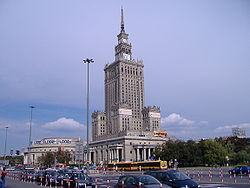- Palace of Culture and Science
-
Palais de la culture et de la science
Le Palais de la culture et de la science (Pałac Kultury i Nauki, PKiN) est le plus grand bâtiment de Pologne, le 6e plus grand d'Europe et le 4e plus grand de l'Union européenne, après la Tour Commerzbank et la Messeturm (toutes deux à Francfort), le One Canada Square (à Londres), mais avant la Tour Montparnasse (à Paris). Il est constitué de 42 étages, de 3 288 pièces et mesure 237 mètres.
Dans un contexte de guerre froide, Staline a tenu à offrir ce bâtiment aux Varsoviens en 1951. Ce gratte-ciel achevé en 1955 est en fait la réplique existant en 7 exemplaires de l'Université d'État de Moscou (la célèbre "Université Lomonossov"). Alors que les Varsoviens sortaient de la Seconde Guerre mondiale, dans un contexte économique difficile, la construction de ce Palais était très controversée.
À la chute du communisme en 1989, un débat a eu lieu sur la possibilité de détruire le bâtiment mais le conseil de la ville l'a gardé. Le PKiN est devenu le symbole de Varsovie et abrite désormais musées, salles de concerts et congrès, 3 cinémas, 2 théâtres et même un restaurant en hauteur avec la plus belle vue de la ville.
En 2001, on y a ajoutée une horloge qui est la deuxième plus haute installée dans le monde (après celle de la Tour NTT DoCoMo Yoyogi de Tōkyō).
La finale de Miss World 2006 a eu lieu au (PKiN)
Liens externes
- Portail de la Pologne
- Portail des gratte-ciel
- Portail du bâtiment et des travaux publics
Catégories : Gratte-ciel de Varsovie | Architecture soviétique | Architecture stalinienne
Wikimedia Foundation. 2010.

